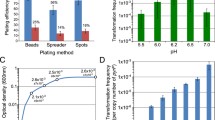Summary
After introduction of the broad host range plasmid RP4 inXanthomonas campestris pv.citri strain XAS4501 twoXanthomonas transposable elements, ISXC4 and ISXC5, were isolated. These elements were found to be capable of transposition inEscherichia coli. Restriction analysis, DNA hybridization and heteroduplex experiments revealed that ISXC4 and ISXC5 are about 5.55 and 6.95 kb in size, respectively, possess inverted repeats about 50±18 bp in length and share DNA homology in their left (5.0 kb) and right (0.6 kb) ends. ISXC4 and ISXC5 were found to originate from plasmids pXW45N and pXW45J, which are indigenous replicons inX. campestris pv.citri strain XW45.
Similar content being viewed by others
References
Boyer HW, Roulland-Dussoix D (1969) A complementation analysis of the restriction and modification of DNA inEscherichia coli. J Mol Biol 41:459–472
Burkardt H, Lurz R (1984) Electron microscopy. In: Pühler A, Timmis KN (eds) Advanced molecular genetics. Springer-Verlag, Berlin, Heidelberg, New York, Tokyo, pp 281–302
Chang ACY, Cohen SN (1978) Construction and characterization of amplifiable multicopy DNA cloning vehicles derived from the P15A cryptic miniplasmid. J Bacteriol 134:1141–1156
Comai L, Kosuge T (1980) Involvement of plasmid deoxyribonucleic acid in indoleacetic acid synthesis inPseudomonas savastanoi. J Bacteriol 143:950–957
Curtiss III R, Charamella LJ, Berg CM, Harris PE (1965) Kinetic and genetic analyses ofd-cycloserine inhibition and resistance inEscherichia coli. J Bacteriol 90:1238–1250
Dagert M, Ehrlich SD (1979) Prolonged incubation in calcium chloride improves the competence ofEscherichia coli cells. Gene 6:23–28
Dai H, Tsay SH, Kuo TT, Lin YH, Wu WC (1987) Neolysogenization ofXanthomonas campestris pv.citri infected with filamentous Cf16. Virology 156:313–320
Datta N, Hedges RW (1972) Host ranges of R factors. J Gen Microbiol 70:453–460
Datta N, Hedges RW, Shaw EJ, Sykes RB, Richmond MH (1971) Properties of an R factor fromPseudomonas aeruginosa. J Bacteriol 108:1244–1249
Haseltine WA, Lindan CP, D’Andrea AD, Johnsrud L (1980) The use of DNA fragments of defined sequence for the study of DNA damage and repair. Methods Enzymol 65:235–248
Hohn B, Collins J (1980) A small cosmid for efficient cloning of large DNA fragments. Gene 11:291–298
Hooykaas PTT, Van Brussel AAN, den Dulk-Raas H, Van Slogteren GMS, Schilperoort RA (1981) Plasmid controlling the symbiotic association betweenR. trifolii and clover plants expressed in different rhizobial species and inAgrobacterium tumefaciens. Nature 291:351–353
Ish-Horowicz D, Burke JF (1981) Rapid and efficient cosmid cloning. Nucleic Acids Res 9:2989–2998
Jordan E, Saedler H, Starlinger P (1968) 0°- and strong-polar mutations in thegal operon are insertions. Mol Gen Genet 102:353–363
Kahn M, Kolter R, Thomas C, Figurski D, Meyer R, Remaut E, Helinski DR (1979) Plasmid cloning vehicles derived from plasmids ColE1, F, R6K and RK2. Methods Enzymol 68:268–280
Kleckner N (1981) Transposable elements in prokaryotes. Annu Rev Genet 15:341–404
Kuo TT, Lin YH, Huang CM, Chang SF, Dai H, Feng TY (1987) The lysogenic cycle of the filamentous phage Cf1t fromXanthomonas campestris pv.citri. Virology 156:305–312
Lanka E, Lurz R, Fürste JP (1983) Molecular cloning and mapping ofSph I restriction fragments of plasmid RP4. Plasmid 10:303–307
McDonell MW, Dimon MN, Studier FW (1977) Analysis of restriction fragments of T7 DNA and determination of molecular weights by electrophoresis in neutral and alkaline gels. J Mol Biol 110:119–146
Nuti MP, Lepidi AA, Prakash RK, Schilperoort RA, Cannon FC (1979) Evidence for nitrogen fixation genes on indigenousRhizobium plasmids. Nature 282:533–535
Rigby PW, Dieckmann M, Rhodes C, Berg P (1977) Labeling deoxyribonucleic acid to high specific activity in vitro by nick translation with DNA polymerase I. J Mol Biol 113:237–251
Smith CA, Thomas CM (1983) Deletion mapping ofkil andkor functions in thetrfA andtrfB regions of broad host range plasmid RK2. Mol Gen Genet 190:245–254
Southern EM (1975) Detection of specific sequences among DNA fragments separated by gel electrophoresis. J Mol Biol 98:503–517
Tu J, Prangishvilli D, Huber H, Wildgruber G, Zillig W, Stetter KO (1982) Taxonomic relations between Archaebacteria including 6 novel genera examined by cross-hybridization of DNAs and 16S rRNAs. J Mol Evol 18:109–114
Tu J, Wang HR, Chou HC, Chang SF (1987) Hydroxylapatite-polyethylene glycol (HA-PEG) procedure: an effective method for recovering DNA from agarose gel. Bot Bull Acad Sinica 28:109–116
Van Larebeke N, Engler G, Holsters M, Van den Elsacker S, Zaenen I, Schilperoort RA, Schell J (1974) Large plasmid inAgrobacterium tumefaciens essential for crown gall-inducing ability. Nature 252:169–170
Wahl GM, Stern M, Stark GR (1979) Efficient transfer of large DNA fragments from agarose gels to diazobenzyloxymethyl-paper and rapid hybridisation by using dextran sulfate. Proc Natl Acad Sci USA 76:3683–3687
Wu WC, Hong YR, Huang CM, Tan YY, Lee CI, Chang SF, Wang CH, Huang ML (1985) Phage-induced mutations inXanthomonas campestris pv.citri. Plant Prot Bull (Taiwan, ROC) 27:19–33
Wu WC, Ju SH, Lee SJ, Maa HI, Huang ML, Yang BC, Kuo HF, Hsueh YK (1986) Variations inXanthomonas campestris pv.citri. Plant Prot Bull (Taiwan, ROC) 28:241–252
Author information
Authors and Affiliations
Additional information
Communicated by J. Schell
Rights and permissions
About this article
Cite this article
Tu, J., Wang, HR., Chang, SF. et al. Transposable elements ofXanthomonas campestris pv.citri originating from indigenous plasmids. Molec. Gen. Genet. 217, 505–510 (1989). https://doi.org/10.1007/BF02464924
Received:
Issue Date:
DOI: https://doi.org/10.1007/BF02464924




